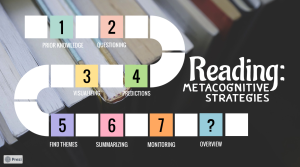16 Metacognitive Reading Introduction
Learning Objectives
-
Discover how metacognitive reading works and explore some of the known metacognitive reading strategies.
-
Use metacognitive reading strategies before, during and after reading fiction, non-fiction and graphics.
Attribution Note: The central ideas of this unit are derived from Kathy Mills’s 2008 paper “The Seven Habits of Highly Effective Readers” (ALEA) with research from N.K. Duke and P.D. Pearson’s “Effective practices for developing reading comprehension” (Journal of Education, 2002).
Chapter & Discussion
This chapter includes a presentation that can be navigated in a classroom setting or independently. You can access the presentation via the link below.
Reading: Metacognitive Strategies
Work through the different sections of the chapter and discuss ideas and topics as they arise. If you’re working independently, take notes instead. Notes and active discussion will be helpful in navigating this week’s assignments.
Overview
Metacognitive means self-aware. It is often used to describe concepts that deal with thinking about thinking.
When you practice reading, you gain better comprehension when you use metacognitive strategies than just with practice alone.
In this course, we will practice the most effective strategies for metacognitive reading with a series of guided lessons and activities.
Today, we’ll take notes on these strategies and start a conversation on how you can integrate them into your reading.
What We Know
Strong readers tend to be active readers. They usually have clear goals in mind for their reading, and often evaluate whether or not those goals are being met. These readers tend to:
• Pre-read and think about the structure of the text
• As they read, they frequently make predictions about what is to come
• Ask questions as they read
• Learn vocabulary through reading
• React academically and emotionally to their reading
• Think about their book when they take a break
• Summarize and re-evaluate as the circumstances change
• Enjoy the process
With this in mind, let’s consider some strategies that can help us strengthen our reading skills by thinking about these skills while we read.

Prior Knowledge
The first metacognitive reading strategy is to activate your prior knowledge about a text before reading it. This is sometimes known as pre-reading.
The goal of this strategy is to help you comprehend new information by considering things you already know about the topic or text. This could come in the form of researching the topic, reading the dust jacket, checking out reviews, watching a video on the reading, or discussing it with someone who has read it.
Relevant Questions: What does this remind you of? What do you already know about this topic?
Questioning
Another strategy is to ask questions before, during, and after reading to clarify meaning and focus your attention on what’s important.
Asking questions keeps your mind engaged and helps you focus. This can help you discover the author’s main ideas and help you see how details support them.
Example Questions:
What is this text about?
What will the next section be about?
What is the most important information?
What have I missed?
What is my opinion of this topic?
Visualizing
Another successful strategy is to practice making strong mental images when you read. This will create an imprint of both the language data and the visual data in your mind (and it will link them). This makes you more equipped to understand and retain the information.
The ability to visualize links the text to a concrete experience – image, feeling, sound, small, or even taste. Making a mental picture is an important fix-up strategy that readers use when they experience difficulty understanding a text. Students can imagine what the scene or characters look like. They then describe to a peer what they see in their mind.
Relevant Questions: What does this scene look like? What does this character wear? How does this person’s voice sound?

Making Predictions
Another important strategy is to make predictions about what will happen next in a reading. This will help you to keep track of the relevant information and help you make use of it.
It doesn’t matter if your prediction is right or wrong. The fact that you made it helps you to constantly “keep score” and this greatly improves comprehension.
Predictions make connections between new knowledge and the known.
Relevant Questions: What will happen next? How did the last chapter influence the next one? How might this foreshadowing come up later?
Finding Themes
The next strategy is to look for main ideas or themes as you read. We write because we have something to say. Every reading is trying to communicate big ideas to the audience.
When we read, we should try to keep track of what information is the main idea and what information is supporting details (everything is either one or the other).
Thinking about the author’s purpose and audience while you read can help with this. It also helps to ask yourself what conclusion this information adds up to as you consider a paragraph or a whole chapter.
This will help you sift out relevant and useful information.
Relevant Questions: What is the author trying to say? What is the topic? What is the author saying about this topic?
Summarizing
The next strategy is to summarize what you’ve read. This is a powerful way to improve overall comprehension of text.
The ability to summarize information requires readers to sift through large units of text, figure out what’s important, and then create a new text that reflects only the important information. This is a difficult task. When you do it, you are practicing and strengthening the toughest comprehension skills.
Relevant Questions: What happened in that chapter that changed the circumstances? What are the most important details of that scene? How has the score changed due to these events?
Self-Monitoring
The final strategy is to self-monitor your understanding as you read. Strong readers know when they don’t understand the text they are reading. This is a good thing. When you know that you didn’t understand something, you can go back and decode it.
As you read, consider when something doesn’t make sense, what doesn’t make sense, and whether the unclear portions are relevant to your overall understanding of the topic.
Relevant Questions: Based on the context, what might that word mean? How might that passage fit into my overall understanding of this story? What might the author be trying to do here?

Assigned Reading
Here are this week’s readings. Additionally, please read for your own personal enjoyment for 1/2 hour each day. This will be called your “Reading Zone” reading and it will coincide with many upcoming activities.
How to Practice Effectively For Just About Anything by Annie Bosler and Don Greene (via TEDEd)
Problem Set: Practice Your Skills!
Click here to complete a ten-question problem set on concepts in this chapter.
Completing problem sets like this can be an important element of independent study towards completing your HSE. I write these to resemble the style of questions you’ll find on the Reading and Language Arts GED.
Assignment: Vocabulary Self-Test
Define the below terms to the best of your memory. If you don’t know one of them, take a guess, but make this answer bold in your document. Here are the terms:
Metacognitive
Comprehension
Pre-Reading
Visualizing
Prediction
Theme
Main Idea
Supporting Details
Sift
Summarize
Self-Monitor
Decode
Assignment: Reading Zone Response (250 Words)
For Reading Zone, you must find a novel that is interesting to you and enjoyable to read. If you need help finding a Reading Zone book, please ask. Please read your Reading Zone book for a half-hour each day. On class days, there will be time in class dedicated to reading.
Create a two-paragraph response to the reading you did this week. The first paragraph should summarize what you read this week. The second paragraph should address the following prompt:
Look at this week’s Guided Discussion on Metacognitive Reading. Which of these strategies are you good at? Which could use some practice? Pick one of these and practice it when you read next. Describe your experience.


